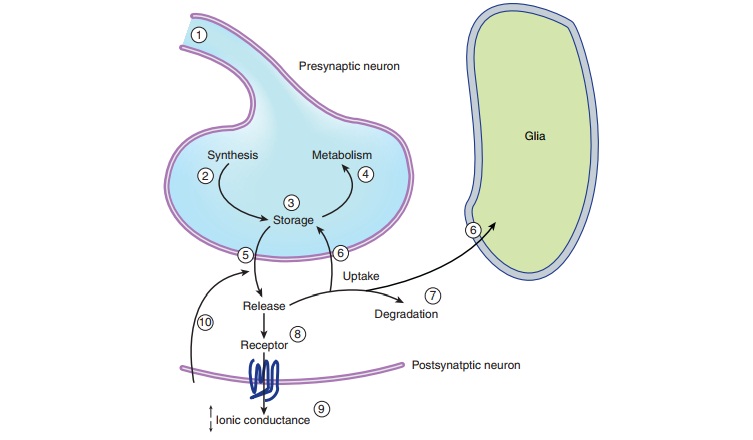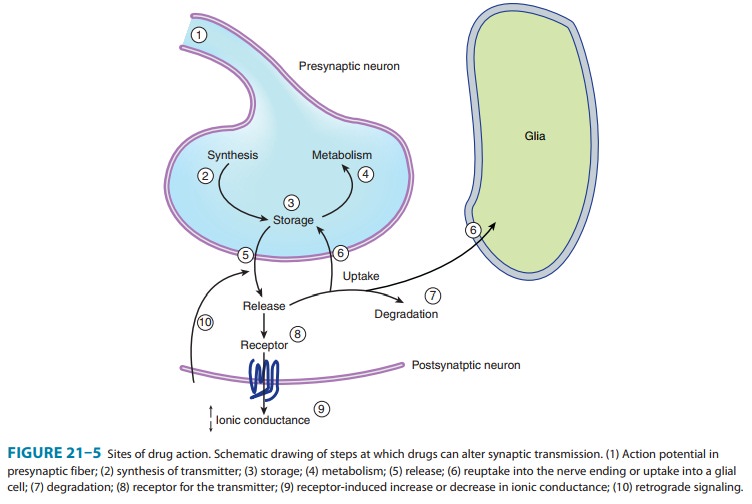Chapter: Basic & Clinical Pharmacology : Introduction to the Pharmacology of Central Nervous System (CNS) Drugs
Sites of Drug Action

SITES OF DRUG ACTION
Virtually
all the drugs that act in the CNS produce their effects by modifying some step
in chemical synaptic transmission. Figure 21–5 illustrates some of the steps
that can be altered. These transmitter-dependent actions can be divided into
presynaptic and postsynaptic categories.
Drugs
acting on the synthesis, storage, metabolism, and release of neurotransmitters
fall into the presynaptic category. Synaptic transmission can be depressed by
blockade of transmit-ter synthesis or storage. For example, reserpine depletes
monoam-ine synapses of transmitters by interfering with intracellular storage.
Blockade of transmitter catabolism inside the nerve ter-minal can increase
transmitter concentrations and has been reported to increase the amount of
transmitter released per impulse. Drugs can also alter the release of
transmitters. The stimulant amphetamine induces the release of catecholamines
from adrenergic synapses. Capsaicin causes the release of the peptide substance
P from sensory neu-rons, and tetanus toxin blocks the release of transmitters. After
a transmitter has been released into the synaptic cleft, its action is
terminated either by uptake or by degradation. For most neu-rotransmitters,
there are uptake mechanisms into the synaptic terminal and also into
surrounding neuroglia. Cocaine, for example, blocks the uptake of
catecholamines at adrenergic syn-apses and thus potentiates the action of these
amines. However, acetylcholine is inactivated by enzymatic degradation, not
reuptake. Anticholinesterases block the degradation of acetylcho-line and
thereby prolong its action. No uptake mechanism has been found for any of the
numerous CNS peptides, and it has yet to be demonstrated whether specific
enzymatic degradation ter-minates the action of peptide transmitters.

In
the postsynaptic region, the transmitter receptor provides the primary site of
drug action. Drugs can act either as neu-rotransmitter agonists, such as the
opioids, which mimic the action of enkephalin, or they can block receptor
function. Receptor antagonism is a common mechanism of action for CNS drugs. An
example is strychnine’s blockade of the receptor for the inhibitory transmitter
glycine. This block, which underlies strychnine’s convulsant action,
illustrates how the blockade of inhibitory processes results in excitation. Drugs
can also act directly on the ion channel of ionotropic receptors. For example,
barbiturates can enter and block the channel of many excitatory ionotropic
receptors. In the case of metabotropic receptors, drugs can act at any of the
steps downstream of the receptor. Perhaps the best example is provided by the
methylxanthines, which can modify neurotransmitter responses mediated through
the second-messenger cAMP. At high concentrations, the methylxanthines elevate
the level of cAMP by blocking its metabolism and thereby prolong its action.
The
traditional view of the synapse is that it functions like a valve, transmitting
information in one direction. However, it is now clear that the synapse can
generate signals that feed back onto the presynaptic terminal to modify
transmitter release. Endocannabinoids are the best documented example of such retrograde signaling. Postsynaptic
activity leads to the synthesis andrelease of endocannabinoids, which then bind
to receptors on the presynaptic terminal. Although the gas nitric oxide (NO)
has long been proposed as a retrograde messenger, its physiologic role in the
CNS is still not well understood.
The selectivity of CNS drug action is based almost entirely on the fact that different transmitters are used by different groups of neurons.
Furthermore, these transmitters are often segregated into neuronal systems that
subserve broadly different CNS functions. Without such segregation, it would be
impossible to selectively modify CNS function, even if one had a drug that
operated on a single neurotransmitter system. That such segregation does occur
has provided neuroscientists with a powerful pharmacologic approach for
analyzing CNS function and treating pathologic conditions.
Related Topics